This article is a part of CNN Underscored’s Earth Week, a weeklong focus on our planet and ways to celebrate and preserve it. We’ll be featuring tips on how to live more sustainably, products to help you spend more time in nature and exclusive deals all week, so check in every morning to see what’s new, and be sure to subscribe to the CNN Underscored newsletter to see it all.
If you’re trying to be more eco-friendly, finding more sustainable solutions to products you use every day is an easy way to lower your impact. Stasher bags and reusable totes might have helped you cut down on your single-use plastic waste, but the paper products you throw away and flush down your toilet every day also have a devastating impact on the environment.
The Natural Defense Council examined the effect of paper products using virgin pulp on the Canadian boreal forest in its 2019 Issue With Tissue report, and found that between 1995 and 2015, more than 28 million acres of the forest was logged, about the size of Ohio. According to the report, the Canadian boreal forest is the main provider of tissue pulp for the United States, which has the second-largest tissue market in the world at $31 billion.
Along with wasting less toilet paper overall by using a bidet, one of the best ways to combat this deforestation is to stop using paper products that are made from virgin pulp, which means looking to recycled alternatives. You might think recycled toilet paper is inferior to normal toilet paper — that it isn’t soft enough or strong enough — but our favorite recycled toilet paper brand, Who Gives A Crap, is here to prove you wrong.
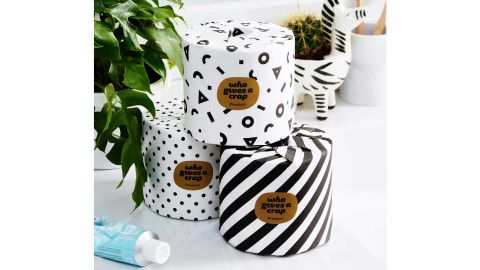
We’ve used Who Gives A Crap products for years but wanted to learn more about its mission, sustainability and how exactly its products are made. So we chatted with Danny Alexander, co-founder and chief of product and purpose (chief of PP) at Who Gives A Crap, to get the lowdown.
“Who Gives A Crap was founded with the goal of solving problems; in particular there were two problems we wanted to address,” says Alexander. “The first one is about environmental sustainability.” He says that in the past, most environmentally friendly products were marketed in a niche way and the quality wasn’t up to par of what consumers expected. He says Who Gives A Crap set out to make a product where the most environmentally friendly option was also the best option. “When it comes to toilet paper, that meant making recycled or alternative fiber papers high-quality, affordable, convenient and delightful in every way,” he says.
Besides sustainability, Alexander says the other big problem Who Gives A Crap wants to help solve is the fact that billions of people worldwide don’t have access to adequate water and sanitation facilities. “The toilet, the world’s most life-saving invention, is out of reach for billions of people around the world,” says Alexander. “Our big, airy, audacious goal as a business is to ensure that every single human on Earth has access to clean water and a toilet by the year 2050.”
Who Gives A Crap plans on solving that problem by donating 50% of the company’s profits to charities and organizations actively working to provide clean water and sanitation to communities across the globe. As of publication, Who Gives A Crap has donated over $10,800,000 AUD to help solve the crisis.
How Who Gives A Crap toilet paper is made
Who Gives A Crap’s signature product is its recycled toilet paper. Instead of cutting down trees and using virgin pulp, Who Gives A Crap takes recycled paper and turns it into high-quality toilet paper. “In order to recycle paper, you have to sort of chop it up and mix it with water, and every time you chop it up, you cut the fibers a little bit,” says Alexander. “Recycling paper is not an infinite loop. Every time we recycle it, it gets a little bit shorter, so we choose the highest grade of paper we can to recycle so that we can have the highest-quality toilet paper.”
Using recycled paper drastically reduces the impact paper companies have on forests, and the Natural Resource Defense Council’s 2019 report emphasizes the effect recycled paper could have on the industry. “The only way for tissue products to become sustainable is for companies to stop the tree-to-toilet pipeline,” the report says. “The best way to achieve this is to transition to recycled fibers, including the highest feasible percentage of postconsumer recycled content.” And in the council’s 2021 update, it ranks Who Gives A Crap 100% Recycled Toilet Paper at the top of its list as the most sustainable option.

However, while Alexander says Who Gives A Crap’s toilet paper is on par if not better than many of its competitors that use virgin pulp, he knows there is still a section of the market that is used to the most premium toilet paper and won’t want to give that up. “What we’ve done to account for that consumer is look for an alternative fiber that was better for the environment but also has the same quality that they were used to,” he says. The result of that search: bamboo.
Bamboo is a grass, so it grows back much faster than a tree, and compared to recycled paper it can provide a stronger, softer feel. “The most environmentally friendly option is the recycled paper, hands down,” Alexander says, but “the bamboo is close behind it.”
On top of using recycled and alternative fibers, Who Gives A Crap has examined its entire supply chain to try to make the most sustainable decisions possible. These include eliminating single-use plastic in its packaging and limiting its use in the entire supply chain, calculating and offsetting carbon emissions from its shipping and more. In the future, Who Gives A Crap wants to keep improving its sustainability and continue to reduce energy consumption and water use in the production process, and it’s even looking into controlling its own distribution network and delivering products with its own fleet of electric vehicles. So while there may be other brands offering recycled or alternative fiber products, Alexander says Who Gives A Crap is always looking at itself holistically to be the most sustainable option available.
How does Who Gives A Crap toilet paper feel?
We’ve used both Who Gives A Crap 100% Recycled Toilet Paper and Premium 100% Bamboo Toilet Paper for years, and we can confidently say it feels extremely similar to the normal toilet paper you’re buying now. The 100% recycled paper may feel a bit scratchier than an ultra-plush option at the store, but it still feels better than thin, single-ply rolls. The bamboo option really does feel like plush toilet paper and, unless you have very high criteria for toilet paper, we doubt you’ll notice a difference.
On top of Who Gives A Crap toilet paper feeling great, its packaging is delightfully colorful and fun. Depending on the toilet paper you buy, it’s wrapped in candy cane-like designs that you won’t feel bad displaying in your bathroom. Plus, each box comes with a few rolls wrapped in gold that say “Emergency Roll!!” so you know when you’re down to the last few and it’s time to order more.
How Who Gives A Crap gives back
“We decided early on that we wanted to partner with organizations that had demonstrated their ability to have high impact and work really effectively around the world, who had local expertise built into all of their teams and who had teams that were incredibly capable of delivering,” says Alexander. To find charities that meet Who Gives A Crap’s high standards, the brand does tons of research and looks at an organization’s track record of success, the team behind the organization, local expertise and the organization’s potential for innovation and disruption.
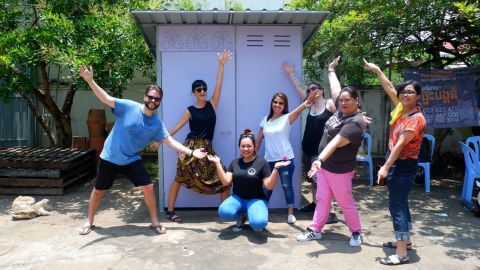
Alexander highlights a few of Who Gives A Crap’s most exciting partnerships, including Wateraid, a large, global NGO that works across Asia, Africa and South America; Shofco, which installs aerial water pipes in the inner cities of Kenya; and Sanergy, which builds and sells toilets, removes waste for customers and turns it into fertilizer that it sells to offset the cost of building toilets.
While Alexander is proud of the work Who Gives A Crap has done, he emphasizes how much work there is left to do. “The scale of the problem is so massive, we’ve donated about 8 million US dollars to date. And that’s super exciting for our team and for our customers,” he says. “The reality is that we have billions of people lacking access; we’re going to need billions if not trillions of dollars activated.”
Is Who Gives A Crap toilet paper worth it?
When you take into account Who Gives A Crap’s sustainability, its charitable efforts and its top-notch quality, there’s no question that Who Gives A Crap toilet paper is worth it. In our opinion, it’s the best option out there for people who want to shop more consciously.
Plus, there’s so much more to buy from Who Gives A Crap if you love and want to support its mission. Beyond toilet paper, the brand also offers tissues, paper towels and biodegradable cloths (similar to the cult-favorite Swedish dishcloths).
More Who Gives A Crap products
Who Gives A Crap 100% Recycled Toilet Paper
From $38 at Who Gives A Crap
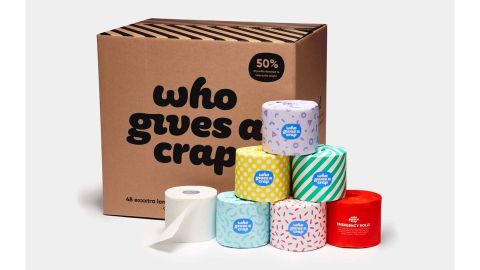
The brand’s signature product, this toilet paper is made from 100% recycled fibers. You can even sign up for a subscription so you’ll never run out.
Who Gives A Crap Premium 100% Bamboo Toilet Paper
From $44 at Who Gives A Crap
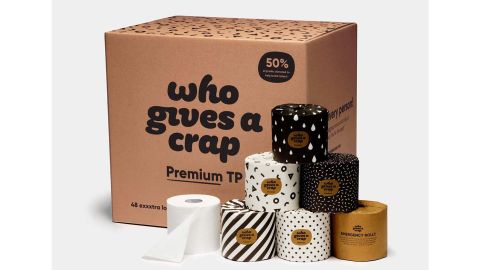
Luxuriously plush and still sustainable, this roll is for the person who wants the most premium toilet paper on the market.
Who Gives A Crap Dream Cloths
$12 at Who Gives A Crap
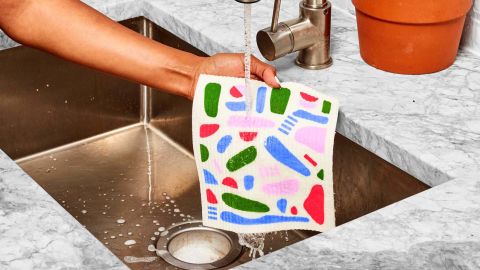
These Dream Cloths are the same thing as the Swedish dishcloths you’ve probably seen. Made with FSC-certified cellulose and reclaimed cotton from the textile industry, these reusable towels are the perfect paper towel replacement. And yes, Who Gives A Crap also offers paper towels, but Alexander says, “We actually hope this cannibalizes our paper towel sales,” since they are much better for the planet than using even Who Gives A Crap bamboo paper towels.
Who Gives A Crap Forest-Friendly Paper Towels
$20 at Who Gives A Crap
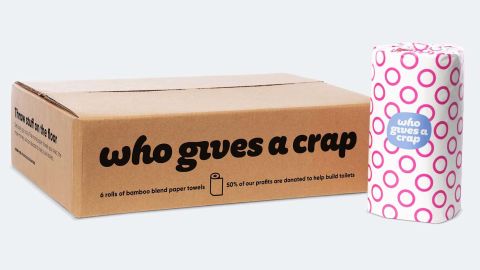
Sometimes you might prefer cleaning up certain messes with a paper towel over a reusable cloth, which is why Who Gives A Crap still offers paper towels, made from a blend of bamboo and sugarcane.
Who Gives A Crap Forest-Friendly Tissues
$20 at Who Gives A Crap

And to complete your transition, Who Gives A Crap also offers tissues made from 100% bamboo so all your paper products can be more earth-friendly.
Source: www.cnn.com

